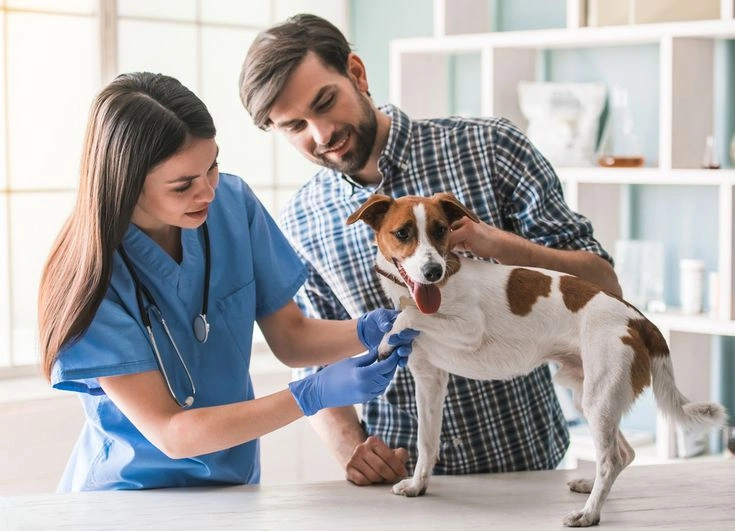Last Updated on March 11, 2024 by Aftab Tariq

They also encourage us to stay active and can keep us company when we feel lonely. This guide will help you get ready to welcome a new furry friend into your family.
It will teach you how to set up their new home, where to find the perfect pet, and what your pet needs to be happy and healthy, from the beginning of their life to the end.
Preparing Your Home for Pets
Ensuring your pet’s new forever home has everything they need is crucial, including creating a plant‑ and pet‑friendly home. Your home may need adjustments, especially if you have plants that could harm your pet if eaten.
- To keep your pets safe, designate one room in your house where all plants are kept and pets are never allowed. This room can also be a safe space for people allergic to your pets.
- If space is limited, consider relocating plants to a mini, enclosed greenhouse to keep them out of your pet’s reach.
- Fake plants with broad leaves can be a good alternative to real plants, reducing the risk of your pet nibbling on them.
- To further reduce accidents, place plants on high shelves or hang them to keep them out of curious pet paws or mouths.
Preparing a safe space for eating and sleeping, brushing up on basic care tips, and ensuring you have the right food for your pet are essential steps in getting your home ready for your new furry friend. Let’s explore what you’ll need and what you should know.
Prepping for a New Dog
Creating a Safe and Happy Home: When welcoming a new furry friend into your home, it’s essential to create a space that’s safe and comfortable for them. Make sure you have all the necessary accessories, like a collar and leash, ID tag, and food and water bowls.

Pet‑proofing your home is crucial to prevent accidents, such as accidental poisoning or swallowing small objects. Keep medications, antifreeze, electrical wires, and cords out of reach. Consider crate training your pet, which provides them with their own safe space to retreat to when needed.
Feeding Your Pet: Puppies should be fed balanced and complete puppy food, with clean, fresh water available at all times. Adult dogs can benefit from balanced and complete dry food, which can be mixed with water, broth, or canned food.
It’s easy to feel overwhelmed by misleading marketing information about pet food, so don’t hesitate to ask your veterinarian for guidance on what, how much, and how often to feed your pet.
Wash food and water dishes daily, and limit their intake of table scraps to maintain a healthy diet.
Basics of Pet Care: Regular exercise is vital for keeping your dog’s mind stimulated and their body healthy. Engaging in fun and games also satisfies their natural instincts to dig, chew, herd, and chase.
Grooming your pet helps reduce shedding and keeps them clean, even if they’re hairless and require specialized grooming.
Prepping for a New Cat
Creating a Happy Home for Your Cat: When preparing your home for a new furry family member, it’s important to create a space where your cat feels safe and comfortable. Start by purchasing all the necessary accessories, such as a litter box, litter, toys, and food and water bowls.

Don’t forget to provide a scratching post for your cat to stretch and sharpen their claws without damaging furniture. It’s also essential to securely screen windows to prevent your cat from escaping when they’re open.
Feeding Your Cat: Cat and kitten food should include meat, which contains taurine essential for eye and heart health. Ensure the food is appropriate for their age, activity level, and health needs.
When in doubt, consult your vet for guidance. Clean water should always be available, and food and water bowls should be washed daily to maintain hygiene.
Basics of Cat Care: While cats are known for grooming themselves, it’s still important to brush or comb your cat regularly to reduce shedding and hairballs. Keeping your cat indoors is best for their health and safety, as outdoor cats are at risk of encountering fleas, ticks, and diseases from other animals.
Choosing the Right Pet for You
When you’re getting a new pet, it’s important to pick one that matches your lifestyle. Every pet has its own needs and behaviors that should fit well with your life. Dogs and cats, for example, have different needs, so it’s essential to think carefully before choosing one.
Here are some questions to help you decide if you’re ready for a pet and what type of pet would be best for you:
- Can you afford to take care of a pet, including vet bills?
- How much time will you spend away from home? Do you have a busy schedule or travel often?
- Who will take care of your pet when you’re not around?
- Are there any potential changes in your life or living situation that might affect your ability to care for a pet in the future?
- Do the rules where you live allow pets, and if so, how many?
- Can you give your pet enough attention and exercise?
- How many years are you willing to commit to taking care of a pet?
- Do you already have pets, and if so, will they get along with a new pet?
- What kind of pet are you looking for? Do you want a pet to relax with at home or one that can join you on active adventures?
- Can you handle the grooming needs of the pet you’re considering?
Household Recommendations
Here are some important tips to keep everyone safe and healthy at home:
- If you have children under 5 years old, it’s best not to have reptiles like turtles or amphibians like frogs. These pets can carry germs like salmonella, which can make little ones sick.
- If you’re pregnant, it’s best to avoid contact with pet rodents to prevent exposure to a virus called lymphocytic choriomeningitis virus. This virus can cause problems for unborn babies.
- Pregnant women should also be careful around stray cats, especially kittens. It’s important to wear gloves and a mask when cleaning litter boxes to avoid getting a disease called toxoplasmosis. Cleaning the litter box once or twice a day can help lower the risk of toxoplasmosis.
- If someone in your household has a weak immune system or has HIV/AIDS, it’s important to be extra careful when choosing and handling pets. Talking to your veterinarian and healthcare provider can help you make the best decision for your family’s health.
Tips on Housing & Future Moves
Finding a new home that welcomes your pet can be tricky, but here are some tips to make it easier for you, your pet, and even your future landlord.
Look for Pet-Friendly Apartments: Some online tools can help you find apartments that allow pets. Just keep in mind that there might be restrictions on the number, type, and size of pets allowed. You may also need to pay extra fees, such as a nonrefundable security deposit.
Consider Private Landlords: Landlords who only have a few properties may be more open to allowing pets. If you’re not sure about a pet policy, don’t hesitate to ask.
Give Yourself Time: Start looking for a new home as soon as you know you need to move. This gives you more time and makes the process less stressful.
Use Local Resources: Check with your local animal shelter or humane society for a list of pet-friendly housing options. You can also look in the newspaper or community rental guides.
Prepare Your Pet’s Resume: Make a document that highlights your pet’s favorite activities, any training certificates they have, and a letter from your vet showing they’re healthy and up-to-date on vaccinations, spayed or neutered, and treated for fleas and ticks.
Know Your Rights: Under Federal and State Fair Housing Regulations, landlords may be required to allow your pet to live with you under certain circumstances.
For instance, if your pet is designated as an Emotional Support Animal or a Service Dog, special accommodations may be necessary. It is recommended to review your state’s official regulations for accurate information.
Where to Get Your New Pet

Pet Adoption / Rescue
Every year, over one million dogs and cats are put to sleep in the United States. But fortunately, these numbers are going down. Some pets in shelters might be euthanized because there’s not enough space.
When you adopt from a local shelter or rescue, you help reduce these numbers and make room for more animals in need, including stray or injured pups or kittens.
Reasons to Adopt or Rescue a Pet: Adopting a pet can also save you money. Many shelters include spaying and neutering, vaccinations, and sometimes even microchipping in the adoption fee.
It can also save you time. Many shelter pets were given up because of human problems like someone in the family passing away, moving, or getting divorced. This means they’re often already trained and used to living with people.
When you adopt, you become part of an inspiring story. The moment you meet your new furry friend at the shelter and know they’re the one, it’s the beginning of a beautiful friendship.
Adopted pets are grateful for their forever homes, and knowing you’ve helped an animal in need can fill you with pride.
Breeders
When looking for a new pet, you might consider getting one from a pet breeder. A pet breeder is someone who owns or leases a female dog to have puppies or kittens. It’s important to visit the place where the animals are raised to make sure they’ve been brought up in a healthy environment.
While some states require breeders to have a license, others do not. You can check if a breeder is licensed with the USDA by using the Inspection Reports Tool.
Reputable breeders take care to match each pet with a family that suits them best. They also try to reduce the risk of health problems in their pets by screening their breeding animals. Because they plan their breedings carefully, it’s common for reputable breeders to have waiting lists for puppies and kittens.
Pet Stores: Another option for getting a pet is a pet store. Some pet stores work with shelters to find homes for available dogs and cats. However, it’s essential to be cautious when buying from a pet store because some pets may come from places called puppy mills.
Puppy mills don’t provide proper care for their animals, so it’s important to make sure you’re getting your pet from a reputable source.
What to Expect from Your New Pet

Dogs
Establishing Routine, Patience, Enrichment, and Training: When you welcome a new dog into your home, it’s crucial to establish a routine that suits everyone in your household. Discuss:
- Decide who walks the dog and when.
- Set regular feeding times.
- Mark off-limits areas in the house.
- Allow time for crate training adjustments.
Introducing enrichment items like stuffed toys or puzzle bowls can keep your dog mentally and physically engaged and help prevent separation anxiety when you’re not around. Remember, accidents may happen as your dog adjusts, so patience is vital during this transition period.
Socialization and Training: Using a crate can provide a safe space for your pet and aid in training, as dogs naturally enjoy having a den. Ensure the crate is spacious enough for your dog’s comfort.
After a settling-in period, introduce your dog to other dogs in neutral outdoor settings while on a leash. Pay attention to their body language and reward good behavior with treats.
Long-Term Care: Consider enrolling in a training course to strengthen your bond with your pet and learn positive reinforcement techniques. Regular playtime and exercise at home are essential for your dog’s well-being, so plan activities like walks and games to keep them active.
Consistency and repetition are crucial for successful training, so ensure everyone in your household follows the same guidelines.
Cats
Establishing Routine, Patience, and Enrichment: Creating a routine for your new cat is essential for their well-being. Make sure to set regular times for feeding, grooming, and play. It’s best to wait until your cat has settled in before introducing grooming activities like brushing their teeth.
Providing a variety of toys and scratching posts can keep your cat entertained and happy. Start play sessions by calling their name and tossing a toy to engage them.
Socialization in the First Weeks: During the initial weeks in their new home, it’s important to help your cat adjust. Keep them separate from any other cats you may have for about two weeks to ease the transition. Be patient and allow your new cat to explore at their own pace.
Use this time to transition them to new food if needed. Older cats, especially if they haven’t had a loving home before, may require extra time to adapt to their new environment and family.
Long-Term Care: Building a relationship with a trusted veterinarian is crucial for your cat’s long-term health. Your vet can assist with any behavior or medical issues that may arise. Providing information about your cat’s grooming and litter box habits can help the vet identify and address any underlying problems effectively.
Veterinary Care

Care for Dogs
Pet Parents Guide: Veterinary Care: When it comes to keeping your pet healthy, vaccinations play a vital role. These are divided into two categories: core vaccinations and non-core vaccinations.
Core vaccines protect against common and severe diseases and are recommended for all pets. Your vet will evaluate your dog’s lifestyle to determine if they need any non-core vaccinations too.
Annual Checkup: Taking your dog for an annual checkup is essential. During this visit, you can discuss any concerns you have with the vet. They may ask about your pet’s diet and daily habits.
- Giving vaccinations or booster shots.
- Checking body weight and condition.
- Running tests on blood, urine, and fecal samples.
- Looking at the coat and skin.
- Preventing fleas, ticks, mites, and other parasites.
- Examining dental health.
Additionally, they’ll check your pet’s coat, skin, and dental health and provide prevention for parasites like fleas and ticks.
Caring for Older Dogs: As your dog ages, they may need more frequent visits to the vet. They’ll require a diet suitable for their age and size, along with regular exercise to keep them healthy and active.
Larger breeds may age faster, so your vet will assess their body condition and provide guidance accordingly. Older dogs are more prone to conditions like arthritis, so they may need special care such as a softer bed for comfort.
End-of-Life Care for Dogs: As your dog approaches their senior years, it’s essential to discuss end-of-life care options with your vet. This involves preparing the family for decisions about palliative care, hospice, or humane euthanasia. Planning ahead ensures your pet’s comfort and dignity in their final days.
Care for Cats
I am a dedicated content writer with more than five years of experience, particularly skilled in the art of storytelling. My writing journey commenced during my college years, where I pursued journalism and unearthed my talent for creating captivating narratives.


